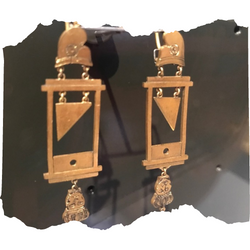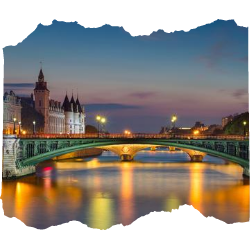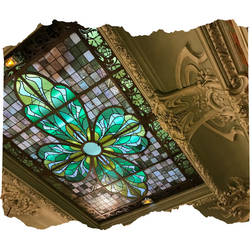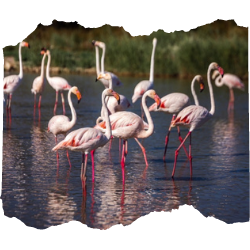Unsure about your French table manners? Click Here to download > > How to avoid these 10 food etiquette mistakes !
- Home ›
- Destinations ›
- Paris ›
- Eiffel Tower Secrets
Secrets Of The Eiffel Tower You Didn't Know About
Updated 31 March 2024 by Leyla Alyanak — Parisian by birth, Lyonnaise by adoption, historian by passion
I've been fortunate to visit the Eiffel Tower several times in my life, and while I don't enjoy the process of getting to the top, once I'm there, you'll have to pull to get me away from one of the most fantastic views on the planet.
I must have been around four years old when I first 'climbed' the Eiffel Tower. I told my father I wanted to walk up the stairs, as one does at that age.
He eventually relented and up we started. Within a minute, I was in his arms, being carried up nearly 350 steps.
I was never able to pull that trick on him again, but I still remember the awe and wonder (and yes, a little bit of terror) at discovering the secrets of the Eiffel Tower and seeing Paris, already beautiful, stretched out below so perfectly even a four-year old could catch her breath.
NOTE: Pages on this site may contain affiliate links, which support this site. See full Privacy Policy here.
How the Eiffel Tower almost wasn't built
- Who designed the Eiffel Tower, really?
- Breaking all speed records
- Everyone hated the tower at first
- It was built to be temporary
- Did you know about the secret apartment?
- The Eiffel Tower's secret names
- Other things Gustave built
- Saved by science
- Advertising on the Eiffel Tower
I've returned since then, riding up the easy way, and each time, I discover something new about the first Iron Lady – things I never expected to find. She truly is one of the more unusual sights of Paris and one of your must-see places when you travel to the city.
Pickpockets in Paris
They're the bane of tourists in Paris but yes, they do exist, and the Eiffel Tower (around the base) is one place they love to hang out: plenty of tourists, many of them looking upwards and not paying much attention to their belongings. Find out how pickpockets operate and, most important, how to avoid getting robbed in Paris.
How the Eiffel Tower almost didn't get built
There's no getting around your Eiffel Tower history lesson, but bear with me because some of these things will be new, even to you!
First, the big picture.
The tower was built by (or under the oversight of) French civil engineer Gustave Eiffel in honour of the 1889 Exposition Universelle, or World's Fair, at the height of the Belle Époque. The fair would celebrate the 100th anniversary of the French Revolution, at a time of rapid modernization and innovation.
This particular design won the competition but Paris was appalled.
The monstrous structure, as it was called, wouldn't exactly fit in with classical Parisian architecture, and anyone who was anyone fought to prevent its building. (You may recall similar arguments were made about the Centre Pompidou and the Louvre pyramid, now accepted and yes, often beloved).
Who designed the Eiffel Tower, really?
Although it was named after Gustave, the tower was actually designed by two engineers (Maurice Koechlin and Émile Nouguier) and an architect (Stephen Sauvestre), all of whom worked for Eiffel.
In fact, when the engineers first showed him their original design, he didn't even like it and it required several iterations before he gave it the green light.
The original design had a central pylon and sat on a monumental arch. Yes, I can imagine how awful that might look.
➽ If you'd rather do your visiting with a guide, here are several multi-day tours that include Paris and the Eiffel Tower.
Building the tower broke every speed record
The initial sketch was drawn up in 1884 and the first foundations poured in 1887.
I won't get into the detail of the concrete slabs and girders and limestone blocks but suffice it to say that at the time, the work was monumental and extremely complex, with designs specified to within one millimeter (.04 inches).
And they weren't off, they were perfect. Scaffolding was made of wood and small cranes were raised along the tower as it was built, a bit hard to imagine today.
Bits and pieces of the tower were manufactured in the nearby Parisian suburb of Levallois-Perret and brought to the site by horse and cart.
In all, 18,038 pieces were assembled using 2.5 million rivets, and based on 1,700 general drawings and 3,629 detailed drawings. More than 300 people were involved in the construction work, which benefited from plenty of safety features, such as rails and screens to prevent workers from falling.
The official number of Eiffel Tower construction deaths was ONE (although a contemporary blurb in the New York Times hinted there might have been as many as 100 Eiffel Tower deaths).
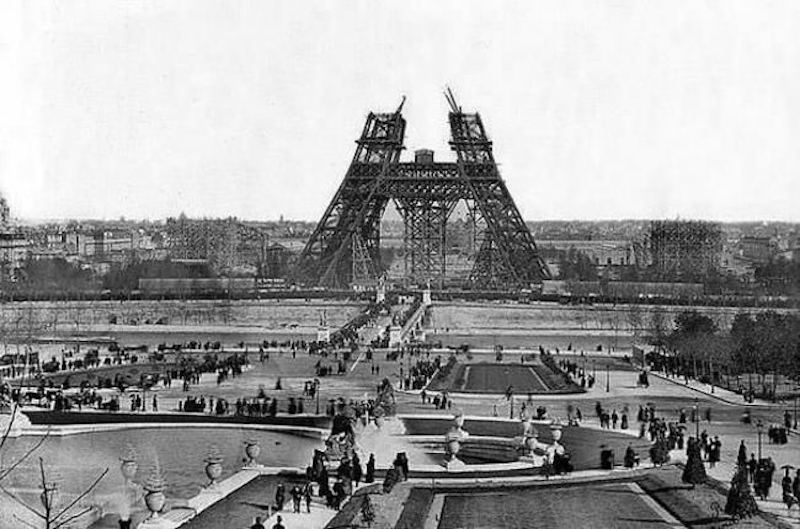
Despite the record-breaking construction (it took 2 years, 2 months and 5 days), it was such a complex undertaking that many people thought it would never be built... and if it did, that it would topple over at the first gust of wind and destroy the beauty that was Paris.
This is the Eiffel book for your inner engineer. Less of a story, more of a reference, the book you need if you want to know how the tower was built, and see a few of the original drawings and photographs.
BUY on AMAZON or from your independent bookshop.
It was a tower much maligned...
As soon as Paris saw the plans, it was up in arms.
"This high and skinny pyramid of iron ladders," wrote Guy de Maupassant.
"A half-built factory pipe," clamored French art critic Joris-Karl Huysmans.
"This truly tragic street lamp," Catholic essayist Léon Bloy called it.
These and other artistic luminaries formed the ‘Committee of Three Hundred’, one member for each meter of the tower's height.
Criticism and insults were flung around, leading to a highly publicized open letter by artists and writers to the exhibition's authorities and which was published in Le Temps:
An extract of the open letter, 1887
"We come, we writers, painters, sculptors, architects, lovers of the beauty of Paris which was until now intact, to protest with all our strength and all our indignation, in the name of the underestimated taste of the French, in the name of French art and history under threat, against the erection in the very heart of our capital, of the useless and monstrous Eiffel Tower which popular ill-feeling, so often an arbiter of good sense and justice, has already christened the Tower of Babel. (...)
To comprehend what we are arguing one only needs to imagine for a moment a tower of ridiculous vertiginous height dominating Paris, just like a gigantic black factory chimney, its barbarous mass overwhelming and humiliating all our monuments and belittling our works of architecture, which will just disappear before this stupefying folly."
Eiffel, not one to bite his tongue, was quick to reply. Here's an excerpt of what he had to say.
Part of Eiffel's response
"For my part I believe that the Tower will possess its own beauty. Are we to believe that because one is an engineer, one is not preoccupied by beauty in one's constructions, or that one does not seek to create elegance as well as solidity and durability ? Is it not true that the very conditions which give strength also conform to the hidden rules of harmony ? (...) Now to what phenomenon did I have to give primary concern in designing the Tower ? It was wind resistance."
And we know who was right.
Eventually, the Eiffel Tower controversy faded once the tower was built. It was a stunning success, and welcomed two million visitors during the World's Fair alone.
Today, of course, it is among the world's most visited attractions (some say the most visited).
The Eiffel Tower was only supposed to stay up a few years
Funny thing though, the tower wasn't supposed to remain.
It was designed to be dismantled after 20 years, once Eiffel had recouped his 80% investment, and sold off for scrap metal. (The mind liquefies.)
Rather than see his masterpiece destroyed, Eiffel hatched a plan: it involved science.
If he could demonstrate its scientific value, he would guarantee its survival. This was, after all, an era of great inventions. So he built an antenna on top of the tower and launched a series of successful wireless experiments, which caught the attention of the French military, and the rest is history.
When World War I erupted a few years later, the tower's value as a radio transmitter was cemented and it became essential to communications with ships and to intercept enemy transmissions.
Author Jill Jonnes tells us the story of the Eiffel Tower, but not only. She veers out into the world and explores the World's Fair for which Eiffel built his tower, a snapshot of the times, involving such colorful characters as Buffalo Bill and Annie Oakley, Thomas Edison and Vincent van Gogh.
BUY on AMAZON or from your independent bookshop.
Every so often, the tower's existence would come under threat.
Towards the end of World War II, Hitler, incensed at his failure to win the war, ordered Paris razed, and the tower along with it. Fortunately, the city's German military governor at the time, Dietrich von Choltiz, was (like many) convinced Hitler had gone crazy and simply ignored the order.
Then, in the 1960s, President Charles de Gaulle had planned to dismantle the Eiffel Tower and send it to Montreal for Expo 67, having apparently made a secret deal with Quebec. Thankfully, the Eiffel Tower's management said No, not trusting the government to bring it back.
There have been plenty of movies about its destruction and threats against it, but she still stands, an emblem of daring and a symbol of French technological genius (or insanity, if you were living in pre-tower Paris), not to mention the more than 120 broadcast antennae that sit at its summit.
The Eiffel Tower secret room (but you knew about it, right?)
I love the fact that Eiffel built himself a secret room at the Eiffel Tower.
And all of Paris, those same Parisians who had vilified Eiffel for even building the tower, clamored for an invite 'up there'.
High society cajoled, begged and even tried to rent the apartment but Eiffel stood firm, possibly smarting from the earlier snubs. Instead, he stuck to a rarefied guest list of his own choosing, the most often-cited guest being Thomas Edison, who apparently gave Eiffel a sound recording machine.
The Eiffel Tower secret apartment was a cosy place (compared to the rest of the modern metallic tower), with a bathroom and a bit of furniture - but no bedroom, which hints the owner never intended to live there. Indeed, he used it to entertain guests, of course, but mostly to run weather and aerodynamic experiments, because it was ideally situated at the top.
You can't enter the apartment but you can see it through a special window – along with wax statues of Eiffel, his daughter Claire and Thomas Edison – if you go to the top of the Eiffel Tower.
➽ Get your Eiffel Tower tickets to the top of the Tower HERE.
The secret names engraved into the tower
Far below the apartment, below the first floor balcony, 72 prominent French scientists and engineers involved in designing the tower had their names engraved into the metal and painted gold.
It's worth noting that these scientists weren't modern - most had been active during the French Revolution at the end of the 18th century.
Their names remind us of past genius, and are also familiar as street names:
- Rue Foucault in Paris, named for Léon Foucault of pendulum fame, who proved that the earth rotates
- Rue Gay-Lussac, also in Paris, for the French chemist who pioneered the study of gas movements
- Rue Joseph Fourier in Chartres, in honour of the mathematician who undertook ground-breaking work in heat transfer and vibrations
- Rue Ampère, for André-Marie Ampère, founder of the science of electromagnetism.
(Here's the full list of names, if you're curious.)
At some point the engravings were, sadly, covered up. But sensibly, the tower's management restored the names in the 1980s and, a few years ago, had their tarnished surface repainted in gold.
Lovely as the homage might be, the list has been male only and doesn't include the name of mathematician Sophie Germain, despite her important work on the theory of elasticity, vital to building the Eiffel Tower.
This is a slight that is about to change as the names of 72 female scholars will now be added, just above the men's names, in the same size and type. Better late than never...
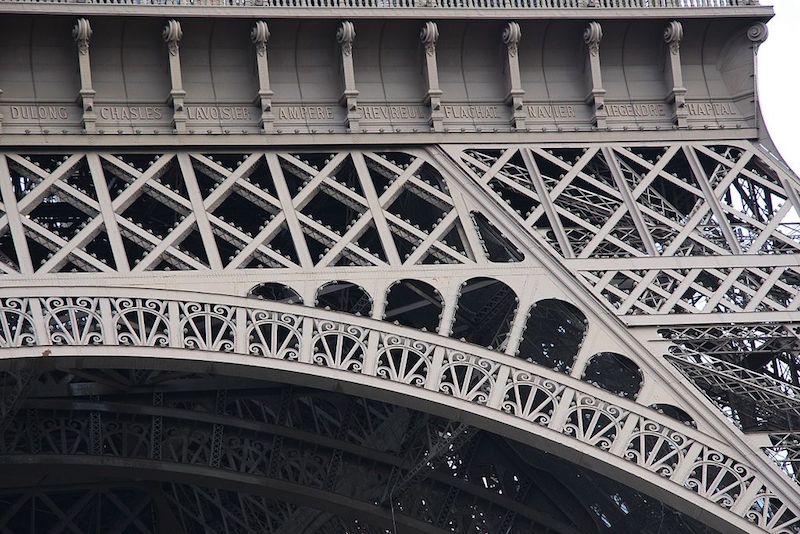 Spot the names?
Spot the names?You'll be surprised at what else was built by Eiffel
We know him for the Eiffel Tower, but that's not his only claim to fame. Gustave Eiffel was born in Dijon (of mustard fame) and, fascinated by metal structures, started his own construction and research firm, with considerable success.
His many non-tower accomplishments include these:
- his first major work was the metallic railway bridge in Bordeaux
- it was followed by the iconic (and wind-resistant) Maria Pia bridge spanning the Douro in the Portuguese city of Porto
- the Budapest Western rail station
- several viaducts in France
- the Pont de les Peixateries Velles in Girona, Spain
- the dome of Nice's observatory
- a major contribution to the building of portable bridges
- and – a lasting accomplishment – the internal metal structure of the Statue of Liberty. On this last point, Eiffel was not the original structural designer; that privilege belonged to the renowned architect Eugene Viollet-le-Duc, who died before the job could be done, hence Eiffel's design
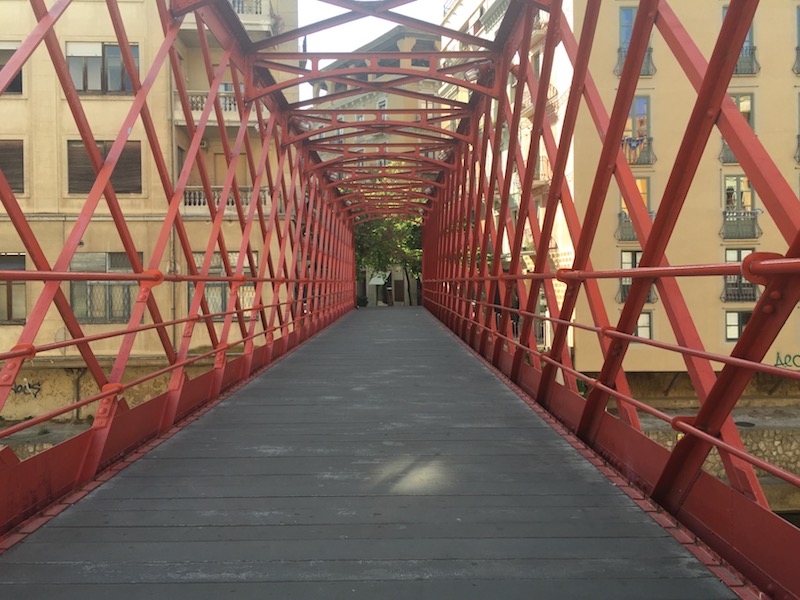 And to think I not only walked across but photographed the Pont de les Peixateries Velles in Girona, Spain, without ever knowing it had been designed by Eiffel... ©OffbeatFrance
And to think I not only walked across but photographed the Pont de les Peixateries Velles in Girona, Spain, without ever knowing it had been designed by Eiffel... ©OffbeatFranceHis last effort was his most noteworthy – in terms of failure: the locks of the Panama Canal, a venture that ended in scandal when the company building the canal (not his) was liquidated. Eiffel, who wasn't at fault, was nonetheless fined and imprisoned for a while.
All in all, Gustave Eiffel built more than 500 structures − some say 1000!
Discover things to do in Paris - Eiffel Tower, Moulin Rouge, Seine + More. Save on activities + Reserve Now and Pay LaterHow the Eiffel Tower was saved by science
The Eiffel Tower's scientific vocation has been well documented.
We know about the meteorology lab on the third floor and its experiments with aerodynamics and physics. But what you might not know is that Eiffel shared his 'lab' with plenty of other scientists. An intriguing discovery was made here: cosmic rays, those tiny high-energy particles that come from outer space.
Vastly more mundane and arguable most useful was Eiffel's invention of the garbage chute, concocted in response to the need to evacuate all the construction material from the tower during building - there was no space to store waste in the tower itself. It was at the time a simple invention: a long hollow tube fixed to the tower frame, through which the garbage found its way downward.
Best hotels with Eiffel Tower view*
➽ LUXURY: Plaza Athénée and Raphaël
➽ MID-RANGE: Le Littré and Duquesne
➽ BUDGET: Relais Saint-Charles and Le Parisis ("budget" is a relative term in Paris)
* Only certain rooms in each hotel have an Eiffel Tower Paris view.
Yes, you can advertise on the Eiffel Tower (if you have a good cause)
A structure as tall and as visible as the Eiffel Tower is irresistible, commercially speaking. Whatever it wears will be seen by every Parisian and millions around the world.
So it is no surprise that in 1925, carmaker Citroen was able to stick its name down the entire length of the tower, an ugly reminder that all is fair when it comes to business. That habit was soon quashed.
Less greedy but equally controversial was the proposal by an AIDS charity to clothe the entire tower with a big red condom. The request was turned down but at least the cause was a good one.
But the tower does support worthy causes, such as the fight against cancer, for which it was lit entirely in pink, or in blue (with the 12 stars of the EU flag) to celebrate France's turn at the European Presidency, or yet again as a symbol of the 2015 Paris climate conference – in green.
That wasn't the end of it and periodically, someone comes up with an idea to use the Eiffel Tower as a prop or as part of a work of art: a Portuguese artist in 2010 who wanted to cover it in a hand-crocheted quilt, or a wildly expensive 2011 proposal to cover the tower entirely with plants.
But perhaps the most outlandish proposal was the very first one, made when the tower was still being built: to shield sensitive Parisians from the "hollow chandelier", as some called the Eiffel Tower, it should be hidden inside an artificial rock 300m high, with waterfalls cascading down the exterior.
Well, not everything is art.
SOME COMMON MISSPELLINGS OF THE EIFFEL TOWER
Spelling the name of this famous French landmark isn't necessarily easy, especially if you haven't seen it before and only heard it pronounced... here are some of the more common spellings you might come across for this monument: effel tower, effial tower, tower eiffel, eff tower, eiffel towered, eiffel towers, ifal tower, iffel tower, iffle tower, ifil tower, the iphal tower, effal tower. They may look strange, but think about it: if you've never seen it in writing, the spelling is anything but obvious...
AND HOW DO YOU PRONOUNCE IT IN FRENCH?
tour-eh-FELL
You might also like these stories!
Would you like more interesting facts about the Eiffel Tower?
Some Eiffel Tower facts:
- Before winning its place in Paris, the Eiffel Tower was first offered to Barcelona, Spain. But the city worried it would be an eyesore (just as Parisians did later) and rejected it. I wonder if they've had second thoughts.
- What is the Eiffel Tower made of? Hint: Long before Margaret Thatcher inherited the label, the Eiffel Tower was known as the Iron Lady.
- The Eiffel Tower was the tallest building in the world – but then New York built the Chrysler Building. So the Eiffel Tower added an antenna and reached past its New York competitor, staying at the head of the list until, eventually, she was surpassed by the Empire State Building.
- The Tower's first official visitors in 1889 were the British royal family, and Buffalo Bill. Nice pairing.
- Doors were thrown open to visitors on 6 May 1889, and the 30,000 visitors had to climb 1,710 steps to reach the top. These days, you can't climb all the way to the top...
- It took another three weeks for the elevators to open. At the time, the tower's five elevators were the highest and most sophisticated in the world.
- These days, most visitors to the Eiffel Tower are from France, followed by those from the United States and Canada, and the United Kingdom.
- The Eiffel Tower was originally illuminated by 10,000 gas lamps. Now, 20,000 flashbulbs glitter each evening, every hour on the hour. The new lights were put up in 2000 for the millennial festivities and were only supposed to stay up a few years. Like the tower itself, the lights have stayed up long beyond their shut-down date.
- Speaking of evenings, you may know it is illegal to publish photos of the Eiffel Tower lit up at night. The lights are considered a work of art and are protected by copyright, its rights reserved. So each time you see a photo of the Iron Lady at night, remember: it may not be legal.
- The tower shrinks and expands by up to 15cm/6in depending on the season. It is also designed to sway about the same amount in the wind (a good thing or it might snap).
- How tall is the Eiffel Tower? It is 324 meters high, or 1063 feet: it is truly one of France's major landmarks.
- It takes 30 painters 18 months to apply a full coat (60 tons) of fresh paint to the tower. It is repainted every seven years. Three shades are used, changing from dark to light as you rise. This actually results in a uniform color. Painting is done the traditional way, with brushes and rollers. By hand.
- The tower is kept running by more than 500 staff. You need that for the seven million yearly visitors.
- The tower has to be stocked daily because there is no room to store things, like... four tons of souvenirs, T-shirts, postcards and the like. The seven bars and restaurants require 6-8 tons of food each day.
- A few years ago, an American woman somehow married the Eiffel Tower. Her new name: Erika La Tour Eiffel. Yep.
- Speaking of marriage, there are two proposals a day at the Tower's Michelin-starred restaurant, Le Jules Verne.
On a final note, the tower has also seen its share of deaths after it was built.
- In 1912, the 'Flying Tailor', Franz Reichelt, jumped to his death while trying out a homemade parachute.
- In 1926, Leon Collet, an aviator, flew through the tower's arches, crashing after getting tangled in some cables.
- In 2009, a young woman killed herself by jumping off.
- A male tourist did the same in 2012, after climbing up the outside frame.
Apparently, there are several suicides each year, although the number has never been made public and there are plenty of safety features in place to prevent accidents and discourage those who want to jump.
Would you like to take a virtual Eiffel Tower tour? Here you go!
Eiffel Tower FAQ
Are there any Eiffel Tower copies?
Absolutely. One of the better known is in Lyon, on Fourvière Hill, next to the Basilica. Other Eiffel Tower replicas of varying sizes can be found in Paris, Texas and Las Vegas, Nevada; Blackpool, England; Tianducheng, China; Tokyo, Japan; Sydney, Australia; Lahore, Pakistan. And there are plenty of others − 80 or more!
What is at the top of the Eiffel Tower?
Gustave Eiffel's reconstituted office and the Champagne Bar.
Is the Eiffel Tower safe?
The structure itself is sound and has withstood any amount of weather-related events. It is also properly secured, with fences and railings, making it pretty much impossible to 'fall off'. Some people worry about the threat of terrorism and other violence, but security is tight and thousands of people visit daily. I'd be more worried about crossing a street without looking both ways.
How many people died building the Eiffel Tower?
There are two competing accounts. One says that officially, one person died during construction. The other says there were zero deaths, and that an Italian builder died when he visited the tower a few days before the inauguration.
Who currently owns the Eiffel Tower?
The city of Paris, which has owned it since it was built.
Why is there a military bunker under the Eiffel Tower?
The bunker is one of the better kept Eiffel Tower secrets. It was built in 1909 to test military telecommunications and radio broadcasting, and came in handy during World War I when it served to thwart secret German efforts and communication messages.
There are reports from people who have visited the Eiffel Tower bunker in recent years but my own efforts to find a tour came to nothing − I've heard the tours are discontinued but have written to the Eiffel Tower press website to see if this is true. I'll update here if they reply.
What are some places close to the Eiffel Tower?
The Iron Lady Eiffel tower is incredibly central. Nearby you'll find the Champs-Elysées, Trocadéro, Palais de Chaillot, Palais de Tokyo, Musée du Quai Branly, Pont de l'Alma, Les Invalides (Napoleon's Tomb)...

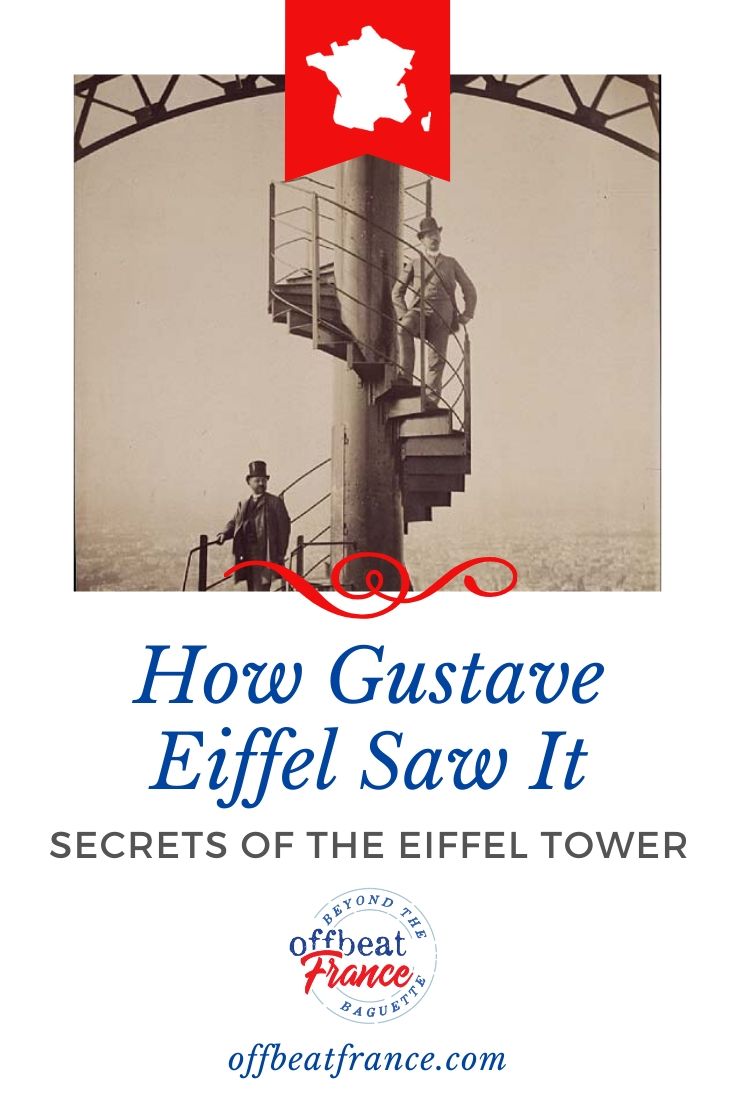
Did you enjoy this article? I'd love if you shared it!
